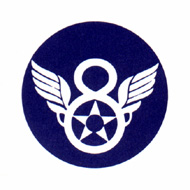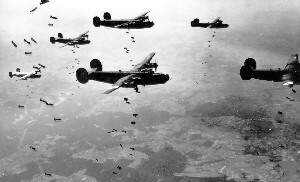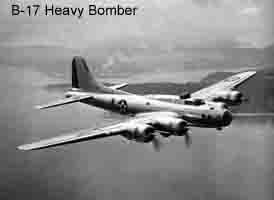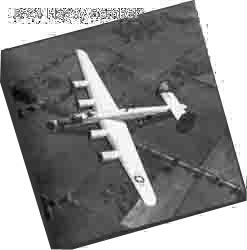|
When the United
States entered the war, the U.S. Army 8th Air Force moved
into the British countryside and set up numerous airfields
in the farms and fields. From these airfields crews
of American B-17 and B-24 heavy bombers flew daylight bombing
raids on strategic targets in German-occupied countries around
Europe. Daylight raids were highly controversial but
Brigadier General Ira Eaker, the commander of the 8th Air
Force believed it was the only way military targets could
be successfully hit. The practice required dropping the bombs
from high altitudes where accuracy was a severe problem.
The development of new sophisticated bomb sights produced
better results but the accuracy of strategic bombing remains
a challenge to this day.
|
|
Due to differences
in flight characteristics, mixed squadrons of B-24s and B-17s
were impractical. In fact they were dangerous when
flying in close formation. For this reason, and for
effeciency in supply and maintenance, it quickly became the
standard to separate the two aircraft into different groups.
|
|
The
B-24 Groups
In
September, 1942, the 93rd Bomb Group became the first U.S.
Army Air Corps group in England flying B-24s. They were followed
within the same month by the 44th Bomb Group. Soon the 93rd
BG was temporarily assigned to duty in North Africa and the
lone 44th BG was joined in June/July of 1943 by the 389th
Bomb Group. By May of 1944, the 8th Air Force contained 19
B-24 Bomb Groups.
|
|
The
Mighty 8th:
The
8th Air Force was activated on 28 January 1942 at Hunter
Field, Savannah, Georgia. Brigadier General Ira C. Eaker
took the first element of the 8th AF overseas on 20 February
1942, when he and a party of six other officers reached England.
A light bomber crew flew the first combat for the 8th AF
in a borrowed Boston on 29 June 1942. The first 8th AF fighter
mission was flown on 26 July 1942. The first heavy bomber
mission was flown on 17 August 1942.
By
D-Day the 8th had reached its peak with a total strength
of over 200,000 persons assigned or attached. Soon after
that time the 8th became able to put up missions with over
2,000 four engined bombers and more than 1,000 fighter aircraft.
It is estimated that the 8th AF employed at least 350,000
persons in WWII. The last bombing mission was flown on 25
April 1945. On 16 July 1945 the 8th AF command left England
and transferred to Okinawa. The war ended before the Eighth
could reach operational status in the Pacific Theater of
Operations. Half of the U.S. Army Air Force casualties in
WWII were suffered by the 8th AF (at least 47,000 casualties
and over 26,000 deaths). Seventeen Medals of Honor, 220 DSCs,
850 Silver Stars, 7,000 Purple Hearts, 46,000 DFCs, and 442,300
Air Medals were awarded to 8AFers by the end of the war.
Many more were awarded after the war. There were 261 fighter
aces in the 8th AF. Thirty-one of these aces had fifteen
or more enemy aircraft to their credit.
The
8th AF was indeed the "Mighty Eighth" (as coined by Roger
Freeman). It has remained mighty up to the present time.
A conservative estimate numbers 650,000 who have served
in the 8th AF since WWII. With this in mind, it is easy
to see that at the time of this writing the 8th AF has
been made up of at least one million Americans. A unique
military unit, matched by none - "The Mighty Eighth." *
*taken
from the Forward to the book Stories of the Eighth,
Edited by John H. Woolnough, Lt Col, USAF (Ret)
Miramar, Florida, July 1983
|



